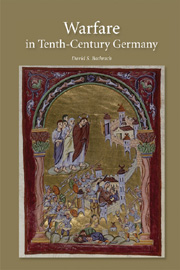Book contents
- Frontmatter
- Contents
- List of Illustrations
- Acknowledgments
- Abbreviations
- Introduction
- 1 Restoring Francia Orientalis: Henry I's Long Term Strategy
- 2 Forging a New Empire
- 3 Military Organization
- 4 Military Education
- 5 Arms and Training
- 6 Morale
- 7 Tactics on the Battlefield
- 8 Campaign Strategy: The Civil War of 953–954
- Conclusion
- Appendix: Major Military Operations by Henry I, Otto I, and Their Commanders
- Bibliography
- Index
- Warfare in History
4 - Military Education
Published online by Cambridge University Press: 05 February 2013
- Frontmatter
- Contents
- List of Illustrations
- Acknowledgments
- Abbreviations
- Introduction
- 1 Restoring Francia Orientalis: Henry I's Long Term Strategy
- 2 Forging a New Empire
- 3 Military Organization
- 4 Military Education
- 5 Arms and Training
- 6 Morale
- 7 Tactics on the Battlefield
- 8 Campaign Strategy: The Civil War of 953–954
- Conclusion
- Appendix: Major Military Operations by Henry I, Otto I, and Their Commanders
- Bibliography
- Index
- Warfare in History
Summary
Warfare was one of the major occupations and preoccupations of the secular elite in the Ottonian kingdom, as it had been under the Carolingians. More surplus resources were devoted to the preparation for war, the conduct of war, and war's aftermath than to any other activity during the tenth century. As a consequence, the formal education of would-be military commanders proceeded in a manner consistent with the training of other professionals whose occupations similarly benefitted from extensive expenditures by the royal government and magnates, including both secular and ecclesiastical seniores. Those receiving substantial support included master architects, surveyors, engineers, notaries, and estate managers. The education of these highly skilled professionals in the secular world can be compared to the education of clerics charged with the provision of pastoral care, and the administration of important institutions, including monasteries and bishoprics. Like other highly skilled professionals in both the secular and ecclesiastical spheres, military commanders required training in carrying out a wide range of tasks. These included, but were not limited to, strategy, logistics, constructing marching camps, constructing siege equipment, establishing a siege, defending against a siege, choosing a battlefield, battlefield formations, tactics involving foot soldiers, tactics involving mounted forces, providing leadership on the battlefield, maintaining military morale, training fighting men in the use of their arms, and training fighting men to form and maintain battlefield formations.
- Type
- Chapter
- Information
- Warfare in Tenth-Century Germany , pp. 102 - 134Publisher: Boydell & BrewerPrint publication year: 2012

